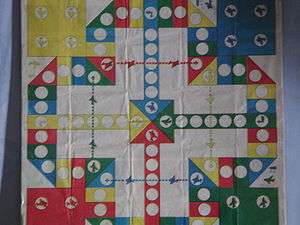Aeroplane Chess
|
An Aeroplane Chess board. | |
| Players | 2-4 |
|---|---|
| Age range | Any |
| Setup time | < 5 minutes |
| Playing time | Around 30 minutes |
| Random chance | High (Dice rolling) |
| Skill(s) required | Dice rolling, Identifying optimal moves |
Aeroplane Chess (simplified Chinese: 飞行棋; traditional Chinese: 飛行棋; pinyin: fēixíng qí, literally "Aviation Game" or "Flying Chess") is a Chinese cross-and-circle board game similar to the western game of Ludo and the Indian game of Pachisi. Developed in the 20th century, Aeroplane Chess features airplanes as pieces instead of the more abstract pawns and beehive-shaped pieces found in the games from which it is derived.
Aeroplane Chess comes in many different packages that are manufactured by different companies. The inventor of Aeroplane Chess is not known and the game has entered the public domain, now ranking among the Jungle Game and Luzhanqi as one of China's classic modern board games.[1]
Equipment
- Aeroplane Chess game board, featuring 4 starting "hangars" in each corner, a "track" of 52 spaces circumventing the board, 4 "home zones" each leading from the track to the "end spaces" at the center of the board. The board is evenly divided between the colors red, yellow, blue and green.
- 4 sets of 4 coloured airplane pieces, typically red, yellow, blue and green.
- A 6-sided dice.
Objective
Two to four players each try to get all their own plane pieces from their hangars, located at the corners of the board, into the base of their own color in the center of the board. Each player takes a turn by rolling the dice. On a turn a player may do the following:
- Taxi a piece out of the hangar onto the board. This can only be done by rolling a 5 or 6.
- Move a piece that's on the board clockwise around the track, the number of spaces indicated by the dice.
Additional rules are:
- A roll of 6, whether it is used to enter or move a piece, gives that player another roll. A second 6 gives the player a third roll. If the player rolls a third 6, any pieces moved by the first two 6's must return to their hangar and play passes to the next player.
- When a player lands on an opponent's piece, the opponent returns that piece to its hangar.
- When a plane lands on a space of its own color, it immediately jumps to the next space of its own color. Any opposing planes sitting on these squares are sent back to their hangars.
- There are additional "shortcut" squares. When a plane lands on one of these of its own color, it may take the shortcut, and any opposing planes in the path of the shortcut are sent back to their hangars.This may also by done in succession with the previous rule, with a jump leading to shortcut. Some also play that a direct land on a shortcut may be followed by a jump.
- When a plane lands on another plane in its own fleet, the player may "stack" the pieces and move them as one piece until they reach the center or are landed on by an opponent. When stacked pieces are sent back to their hangar by an opponent landing on them, they are no longer stacked. (Some play without this stacked movement rule.)
Ending the game
Plane must fly into the center base on an exact roll. When a plane does so, it is placed facedown back in its own hangar, indicating that it is done for the game. The first player to get all of four of their planes to the center of the board wins. The rest play until there is only one loser.
Optional rules
Like many other board games, people add their own rules that give the game a colloquial and folkloric quality:
- Open Shortcut Rule: A player landing on a shortcut space may move along its path, regardless of color. A shortcut of corresponding color gives the player the advantage of being able to make an additional jump, either before or after the shortcut, but not both.
- Stacked Battle Rule: If a player moves a piece or pieces onto an opposing stack that has a greater number of planes than the number landing on the stack, the stack remains and the player moves their plane or planes back one space.
- Dice Battle Rule: When a plane lands on an opposing plane, players determine which gets sent back to its hangar by rolling the die, with the high roll determining the winner. When one plane attacks a stack of planes, it must battle each one by rolling the die. When a stack attacks another stack, the planes battle each other with a series of successive die rolls until only one player occupies the square.
- Home Zone Backtrack Rule: If a player cannot move pieces into the center base by an exact roll of the die, then they must move their piece backwards according to number rolled.
References
- ↑ "Fei Xing Qi". Board Game Geek. Retrieved 29 December 2011.
